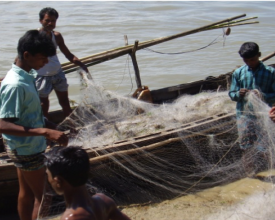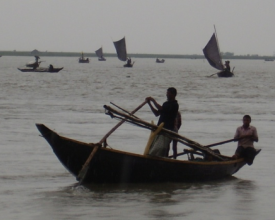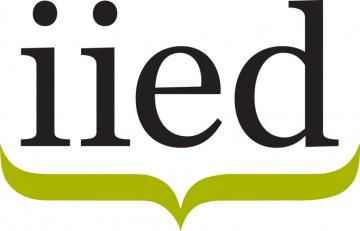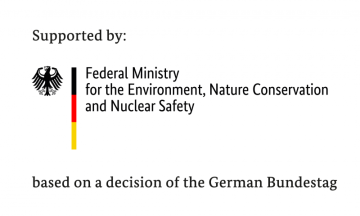
Gestion de la pêche au hilsa basée sur des mesures incitatives
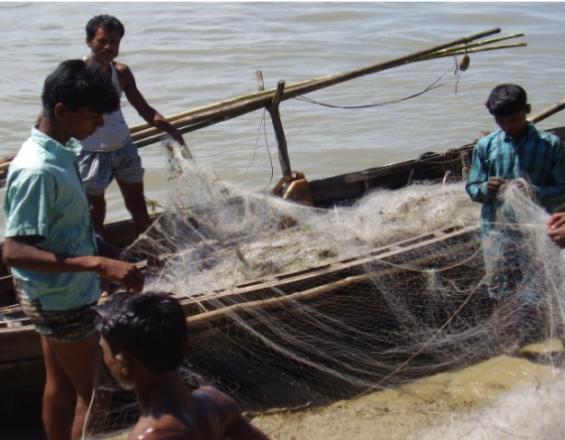
La solution " Incentive-based Hilsa Fisheries Management " comprend une série d'activités directement et indirectement liées à la reconstitution des stocks de hilsa au Bangladesh. Le gouvernement du Bangladesh a associé des interdictions de pêche saisonnières et la création de sanctuaires pour le hilsa à des programmes d'aide sociale basés sur l'alimentation et les revenus ; l'objectif était de maximiser la reconstitution des stocks de poissons et de minimiser la charge imposée aux pêcheurs en limitant leur accès à ce poisson important sur le plan culturel et économique. Les stocks de hilsa et d'autres espèces auraient augmenté et le poids des prises de hilsa aurait à peu près doublé depuis le début du plan de gestion. Les communautés sont soutenues lorsqu'il n'est pas possible de pêcher, notamment par le biais d'un programme alimentaire. Cette solution est publiée dans le cadre du projet "Adaptation basée sur les écosystèmes : renforcer les preuves et informer les politiques", coordonné par l'IIED, l'UICN et le WCMC de l'ONU-Environnement.
Contexte
Défis à relever
Le poisson Hilsa a une importance économique, sociale et culturelle au Bangladesh. La production de hilsa est en déclin depuis les années 1970 en raison d'une gestion inadéquate (surpêche) et des effets du changement climatique, au point que l'on craint l'effondrement de l'ensemble du stock. Les changements de saison, la salinisation de l'eau, l'érosion des berges, l'augmentation des températures, l'envasement et la multiplication des phénomènes météorologiques extrêmes entraînent une dégradation des sites de reproduction et des habitats, ainsi que des changements dans la morphologie des rivières, ce qui réduit les chances de réussite du frai et influe sur les voies de migration du hilsa. La réduction des stocks de hilsa a des répercussions négatives directes et indirectes sur les populations les plus pauvres du Bangladesh, la pêche au hilsa étant essentiellement artisanale et le hilsa étant le poisson le plus abordable et le plus apprécié des pauvres. Le hilsa est essentiel sur le plan nutritionnel pour quelque 250 millions de Bengalis. Il s'agit également du poisson national du Bangladesh, qui revêt une importance culturelle considérable dans la culture bengalie.
Emplacement
Traiter
Résumé du processus
Les interdictions de pêche au hilsa à l'échelle nationale (BBI) au Bangladesh permettent d'interrompre le frai de ce poisson important sur le plan économique et culturel. Pour minimiser le stress des interdictions de pêche sur les pêcheurs les plus pauvres, qui sont souvent les plus dépendants du hilsa, un programme de compensation (BBII) protège les pêcheurs contre le stress de la perte de leurs moyens de subsistance, en fournissant soit des céréales alimentaires , soit une formation à des revenus alternatifs aux ménages de pêcheurs directement affectés.
Le BBIII, un fonds fiduciaire de conservation proposé, soutiendrait les activités détaillées dans le BBI et le BBII, en aidant à résoudre certains des problèmes de mise en œuvre et de fourniture de services détaillés ci-dessous.
Blocs de construction
Mise en œuvre de l'interdiction de la pêche au hilsa à l'échelle nationale
Chaque année, la capture, la vente, le transport, la commercialisation ou la possession de juvéniles de hilsa sont interdits à l'échelle nationale du 1er novembre au 30 juin, une interdiction totale de 2 à 3 mois sur tous les types de pêche, y compris les espèces cibles de hilsa juvéniles, dans 5 zones sanctuaires (tronçons de rivière) dans les principales zones de reproduction du hilsa et une interdiction supplémentaire de courte durée de 15 jours en septembre/octobre sur quatre sites de frai du hilsa. Cette mesure vise à protéger le stock de poissons hilsa et à permettre un frai ininterrompu. Des rassemblements de bateaux sont organisés pour sensibiliser le public et soutenir les interdictions de pêche, ainsi que les médias, des dépliants et des affiches expliquant l'importance de la conservation du hilsa.
Facteurs favorables
Le gouvernement central doit avoir la volonté et les ressources nécessaires pour pouvoir mettre en place un tel programme à l'échelle nationale - au Bangladesh, il existe une série de lois qui fournissent le cadre juridique nécessaire à la gestion de la pêche au hilsa.
- Pour que l'interdiction de la pêche soit effectivement appliquée, il doit y avoir une bonne coordination entre tous les organismes du gouvernement central compétents en matière de pêche.
- La bonne qualité des données écologiques de base sur le frai est une condition essentielle à l'élaboration d'un calendrier d'interdiction de pêche approprié.
Leçon apprise
La pêche illégale de hilsa juvénile a augmentédepuis 2011 ; l'une des principales raisons en est le manque de ressources disponibles pour soutenir les opérations de contrôle de l'application de l'interdiction la nuit. La corruption (pots-de-vin) a également entravé l'application de l'interdiction. Ces problèmes nuisent à la légitimité perçue de l'ensemble du système de gestion de la pêche.
- La décentralisation et la déconcentration des pouvoirs de gestion et de magistrature pourraient potentiellement atténuer ces problèmes.
- Le manque d'équipements et de fournitures, tels que les bateaux et la nourriture, empêche le personnel de mener à bien les activités de contrôle, même pendant la journée.
- Le sentiment que certains coûts et avantages du plan de gestion de la pêche ne sont pas répartis équitablement : par exemple, il semble que les pêcheurs des pays limitrophes bénéficient de l'augmentation des stocks de poissons résultant des interdictions de pêche qui n'affectent que les pêcheurs bangladais.
Régime de compensation alimentaire et de compensation basée sur le revenu pour les pêcheurs
Pour soutenir le plan global de gestion de la pêche au hilsa, les ménages directement touchés par les interdictions de pêche au hilsa bénéficient d'une compensation en céréales alimentaires ou d'une formation à la création de revenus alternatifs. Les ménages reçoivent soit une ration mensuelle de riz pendant la longue période (quatre mois) d'interdiction de la pêche, soit une formation et du matériel pour les aider à diversifier leurs revenus. S'ils bénéficient de cette dernière option (appelée AIGA - activités alternatives génératrices de revenus), les ménages n'ont généralement pas droit à une compensation sous forme de riz. Dans le cadre des AIGA, les formations proposées comprennent l'élevage, la couture, l'agriculture et le montage de filets.
Facteurs favorables
Les régimes relatifs aux céréales alimentaires et à l'AIGA sont des régimes gouvernementaux qui ont été mis en place avant le régime de la pêche, ce qui signifie que ces régimes pourraient être facilement liés au régime de la pêche.
Leçon apprise
- Les programmes de céréales alimentaires et d'AIGA étant antérieurs au plan national de gestion de la pêche, aucun d'entre eux n'était nécessairement adapté aux complexités des moyens de subsistance liés à la pêche.
- Les ménages bénéficiant de l'AIGA n'avaient généralement pas droit aux céréales alimentaires, et le taux de participation au régime de l'AIGA était très faible - aux alentours de 2014, seuls quelque 0,5 % des ménages ont bénéficié de ce type d'aide.
- Assurer la participation dès le début de la conception du régime d'indemnisation contribuera à résoudre ce problème en garantissant la prise en compte des besoins et des souhaits locaux.
- De nombreux avantages et coûts non monétaires, y compris les coûts d'opportunité, peuvent être très difficiles à comptabiliser et à évaluer.
Fondation pour la conservation de Hilsa
La Fondation pour la conservation du hilsa ferait office de fonds fiduciaire pour la conservation (FFC). Ce fonds apporterait une certaine stabilité financière au programme global de gestion de la pêche au hilsa du Bangladesh, dont l'efficacité a été affectée par le manque de ressources. Un FFC efficace constituerait une source de financement stable et fiable, même en cas de choc économique ou politique national, pour soutenir les activités écologiques et sociales liées à la gestion de la pêche au hilsa, telles que le BBI et le BBII respectivement.
Facteurs favorables
Un atelier multipartite a été organisé en 2015 pour définir les principaux objectifs d'un FFC hilsa : ceux-ci comprenaient la durabilité des programmes de conservation, une large couverture des pêcheurs affectés par les activités de gestion de la pêche au hilsa, une distribution équitable des bénéfices de la conservation du hilsa, des actions visant à promouvoir la restauration et la conservation, et le développement d'activités de subsistance alternatives pour les pêcheurs de hilsa. La participation dès le départ est essentielle pour garantir que les FFC ont des objectifs adaptés au contexte, pertinents et appropriés.
Leçon apprise
- Pour réussir, les FFC doivent respecter certains critères de conception. Il peut s'agir d'une analyse de faisabilité détaillée, de la définition d'un objectif clair et d'une valeur de conservation, d'une structure de gouvernance participative et de normes de suivi et d'évaluation définies.
- Il existe toute une série d'options de financement disponibles pour les FFC - il peut s'agir de recettes fiscales sur les exportations de poisson, de frais pour les bénéficiaires, de prélèvements sur les fonds climatiques existants, de prélèvements sur un dépôt dans un fonds avec un taux de dividende équitable, etc. Le choix du mécanisme approprié dépend du contexte
- Réfléchir attentivement au type de mécanismes institutionnels qui garantiraient une bonne gouvernance dans les FFC - par exemple, un conseil d'administration diversifié (comprenant des hauts fonctionnaires, des ONG, des associations de pêche, le secteur privé) pourrait contribuer à isoler un FFC des agendas politiques.
Impacts
Toute une série de groupes ont bénéficié des améliorations écologiques et des possibilités accrues de revenus tirés de la pêche qui en ont résulté - non seulement les pêcheurs eux-mêmes, mais aussi les personnes impliquées dans le prêt d'argent, le commerce de gros, le commerce de détail, la main-d'œuvre et la fabrication de filets et de bateaux. Les femmes, les enfants et les personnes âgées, qui font partie des populations les plus pauvres du Bangladesh, ont tout particulièrement bénéficié de la reconstitution des stocks de ce poisson favori. L'augmentation des revenus permet à un plus grand nombre d'enfants de poursuivre leurs études et protège les pêcheurs contre les crises économiques, en leur permettant de rembourser plus facilement leurs emprunts. L'augmentation des stocks de poissons améliore la nutrition. D'un point de vue écologique, non seulement le hilsa mais aussi d'autres espèces de poissons ont été signalés comme ayant augmenté au Bangladesh et peut-être en Inde et au Myanmar (bien que la plus forte augmentation perçue des prises soit signalée parmi ceux qui vivent à proximité des zones de sanctuaires de poissons). Le poids des prises de hilsa aurait également doublé en 10 ans, depuis l'introduction des activités de gestion de la pêche. Dans l'ensemble, le programme de gestion de la pêche au hilsa a amélioré la résilience et la capacité d'adaptation des communautés, réduisant ainsi leur vulnérabilité au changement climatique et aux défis qui y sont associés.
Bénéficiaires
Communautés de pêcheurs dépendant de la hilsa au Bangladesh ; pêcheurs d'autres espèces de poissons et de crustacés.
